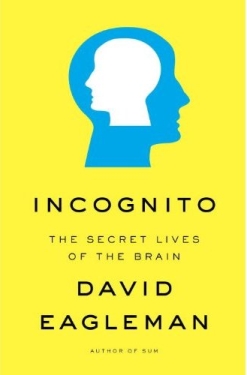If you thought you knew precisely who you are and why you do things the way you do, you’d be in for some stunning surprises when you read David Eagleman’s
Incognito: The Secret Lives of the Brain (Canongate Books Ltd., 272 pages). The new book by the American neuroscientist and
New York Times bestselling author unravels many of the magic tricks the human brain plays on the conscious mind, including why one is more likely to marry someone whose first name begins with the first letter of his or her own first name, or why if one’s name is Dennis or Denise, he or she is statistically more likely to become a dentist—truly irrational decisions that the author says are verifiable from empirical data.

Eagleman harnesses findings in modern cognitive research—some of which he had undertaken himself—to demonstrate that although most people live their lives thinking they know themselves well, they actually know only a tiny portion of what their brains are doing and where their thoughts come from. He says this is because brain activity is for the most part done subconsciously and effortlessly, summarizing vast quantities of data to come up with just hunches on which to base conscious decisions. “Essentially the conscious mind is like a newspaper headline in the sense that all it ever wants is the summary,” Eagleman says, “it doesn’t need to know all the details of how something happened, it just wants to know… it just wants to know what’s happening right now.”
Read an excerpt from David Eagleman’s Incognito in the Scientific American Book Club website now! THIS SITE IS NO LONGER AVAILABLERead an interview with David Eagleman by Betsy Mason in Wired.com now!ABOUT THE AUTHOR:David Eagleman is a neuroscientist at Baylor College of Medicine, where he directs the Laboratory for Perception and Actions as well as the Initiative on Neuroscience and Law. His scientific research is published in the journals
Science and
Nature. He has previously published two books on neuroscience,
Live-Wired: The Shapeshifting Plasticity of the Brain and
Wednesday Is Indigo Blue: Discovering the Brain of Synesthesia, as well as the internationally bestselling book of fiction
Sum: Tales from the Afterlives.
ANOTHER INTERESTING READING:In “Readers of the Pack: American Best-Selling,” an article that came out in
BookForum’s Summer 2011 issue,
New Republic senior editor Ruth Franklin surveys the bestselling fiction and nonfiction books from the late 1800s to the present day to figure out what it takes for a book to make it to the bestseller lists. “Trends come and go, but the best seller remains essentially serendipitous,” she concludes. “An editor can be no more certain of finding the next one than a writer can be assured of writing it.” And she quotes an English scholar who has studied the phenomenon as saying this: “What defines the bestseller is bestselling. Nothing else.”
Read Ruth Franklin’s “Readers of the Pack: American Best-Selling” in BookForum now!